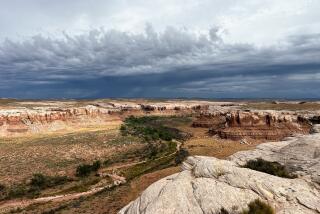Feinstein wants desert swath off-limits to solar, wind
WASHINGTON — While President Obama has made development of cleaner energy sources a priority, an effort is underway to close off a large swath of the Southern California desert to solar and wind energy projects.
In a move that could pit usual allies -- environmentalists and the solar and wind industries -- against each other, Sen. Dianne Feinstein (D-Calif.) is preparing legislation that would permanently put hundreds of thousands of acres of desert land off limits to energy projects. The territory would be designated California’s newest national monument.
The move has triggered cries of NIMBY-ism on Capitol Hill.
“If there is such strong support for renewable energy, then why are they moving to block renewable energy production in their own state?” said Rep. Doc Hastings of Washington state, the top Republican on the House Natural Resources Committee.
Myron Ebell, an energy expert with the pro-market Competitive Enterprise Institute, called Feinstein’s effort “just the first example of how hard it is going to be to realize President Obama’s dream of a green-energy economy.”
Feinstein disputed that she is engaged in a not-in-my-backyard campaign. “I’m a strong supporter of renewable energy and clean technology -- but it is critical that these projects are built on suitable lands,” she said.
The area of concern to Feinstein is between the Mojave National Preserve and Joshua Tree National Park, off old Route 66 between Ludlow and Needles. The area includes desert tortoise habitat, wildlife corridors, cactus gardens and the Amboy Crater -- an inactive volcanic crater where portions of the 1959 movie “Journey to the Center of the Earth” were filmed.
“That section of the road is as pristine as it was when travelers came across it in the 1920s and ‘30s,” said James Conkle, chairman of the Route 66 Alliance.
Boundaries for the proposed monument have yet to be drawn up. But David Myers, executive director the Wildlands Conservancy, said it probably would be in excess of 800,000 acres. Feinstein said in a Capitol Hill interview Tuesday that she was sending her staff to the desert -- and would probably visit the area herself next month -- to consider what areas should be made off limits to green-energy projects and where they should be permitted.
Feinstein, who regards the 1994 California Desert Protection Act as one of her proudest achievements, noted that the Wildlands Conservancy spent more than $40 million buying the former railroad land in the desert and turning it over to the government in one of the largest land purchases in California history, with the intent of protecting it. “I feel very strongly that the federal government must honor that commitment,” she said.
The Bureau of Land Management is reviewing 130 applications for solar and wind energy development in the California desert, covering more than 1 million acres of public land, according to Feinstein, who recently discussed her concerns with Interior Secretary Ken Salazar. At least 19 projects have been suggested in the area where the monument has been proposed, Myers said.
Salazar said in a letter to Feinstein that projects in the desert would be “carefully considered” before any decisions were made and that “every effort will be made to avoid the most environmentally sensitive and valuable areas.” But he also noted that developing cleaner energy sources was a priority.
California Gov. Arnold Schwarzenegger said in a speech last year at a Yale University climate-change conference: “If we cannot put solar power plants in the Mojave Desert, I don’t know where the hell we can put it.”
In November, Schwarzenegger signed an executive order that a third of the state’s electricity come from renewable sources by 2020. A major boost in solar and wind power is an essential component of the state’s plan to cut greenhouse gas emissions under its landmark global warming law. About 12% now comes from renewable sources, excluding large hydropower plants.
His administration, however, has signaled that it will work with Feinstein. A number of companies pursuing solar or energy projects said they hoped to work with Feinstein to fashion legislation that would satisfy her, environmentalists and the industry.
“It’s frustrating. We really do have competing national priorities here,” said Paul Whitworth, whose San Diego-based LightSource Renewables hopes to put in a solar project on about 6,000 acres near Amboy. “We spent a lot of time researching the desert, and consulting with the BLM to make sure we didn’t apply on top of an area of critical environmental concern, or area with other issues. . . . Now, there’s uncertainty on whether these projects will go ahead.”
“What we all know about Sen. Feinstein is that she’s long been a champion for both environmental issues and renewable energy issues,” said Shannon Eddy, executive director of the Large-scale Solar Assn. “I’m certainly hoping that there’s some pathway that we can find here to meet the mutual goals we all have.”
A representative of the U.S. Chamber of Commerce who has fought congressional actions to close off areas to oil and gas drilling questioned where energy projects would be built, if not in the remote desert.
“If you’re going to take the desert away from us, where are you going to allow it -- Los Angeles?,” said Bill Kovacs, the chamber’s vice president for environment, technology and regulatory affairs.
Feinstein holds a position of influence: She chairs the Senate appropriations subcommittee that writes the Interior Department’s budget.
--
More to Read
Sign up for Essential California
The most important California stories and recommendations in your inbox every morning.
You may occasionally receive promotional content from the Los Angeles Times.











